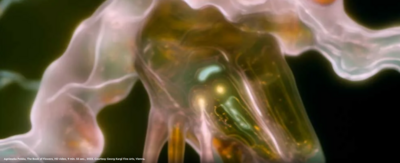Welcome at the Interface Culture program website.
Acting as creative artists and researchers, students learn how to advance the state of the art of current interface technologies and applications. Through interdisciplinary research and team work, they also develop new aspects of interface design including its cultural and social applications. The themes elaborated under the Master's programme in relation to interactive technologies include Interactive Environments, Interactive Art, Ubiquitous Computing, game design, VR and MR environments, Sound Art, Media Art, Web-Art, Software Art, HCI research and interaction design.

The Interface Culture program at the Linz University of Arts Department of Media was founded in 2004 by Christa Sommerer and Laurent Mignonneau. The program teaches students of human-machine interaction to develop innovative interfaces that harness new interface technologies at the confluence of art, research, application and design, and to investigate the cultural and social possibilities of implementing them.
The term "interface" is omnipresent nowadays. Basically, it describes an intersection or linkage between different computer systems that makes use of hardware components and software programs to enable the exchange and transmission of digital information via communications protocols.
However, an interface also describes the hook-up between human and machine, whereby the human qua user undertakes interaction as a means of operating and influencing the software and hardware components of a digital system. An interface thus enables human beings to communicate with digital technologies as well as to generate, receive and exchange data. Examples of interfaces in very widespread use are the mouse-keyboard interface and graphical user interfaces (i.e. desktop metaphors). In recent years, though, we have witnessed rapid developments in the direction of more intuitive and more seamless interface designs; the fields of research that have emerged include ubiquitous computing, intelligent environments, tangible user interfaces, auditory interfaces, VR-based and MR-based interaction, multi-modal interaction (camera-based interaction, voice-driven interaction, gesture-based interaction), robotic interfaces, natural interfaces and artistic and metaphoric interfaces.
Artists in the field of interactive art have been conducting research on human-machine interaction for a number of years now. By means of artistic, intuitive, conceptual, social and critical forms of interaction design, they have shown how digital processes can become essential elements of the artistic process.
Ars Electronica and in particular the Prix Ars Electronica's Interactive Art category launched in 1991 has had a powerful impact on this dialog and played an active role in promoting ongoing development in this field of research.
The Interface Cultures program is based upon this know-how. It is an artistic-scientific course of study to give budding media artists and media theoreticians solid training in creative and innovative interface design. Artistic design in these areas includes interactive art, netart, software art, robotic art, soundart, noiseart, games & storytelling and mobile art, as well as new hybrid fields like genetic art, bioart, spaceart and nanoart.
It is precisely this combination of technical know-how, interdisciplinary research and a creative artistic-scientific approach to a task that makes it possible to develop new, creative interfaces that engender progressive and innovative artistic-creative applications for media art, media design, media research and communication.
Science/Fiction – A Non-History of Plants
Eröffnung: 3. Okt. 2025; ab 19.00 Uhr; Ausstellung bis 18. Jän. 2026 Arsenal Objekt 19A, 1030 Wien
Mit u.a. Helga Traxler, Marie Ruprecht-Wimmer und Violetta Wakolbinger
Eine Ausstellung von FOTO ARSENAL WIEN die FOTO WIEN 2025
Redner*innen:
Veronica Kaup-Hasler, Stadträtin für Kultur und Wissenschaft der Stadt Wien I City Councillor of Cultural Affairs and Science in Vienna
Clothilde Morette, Artistic Director, Kuratorin I Curator & Victoria Aresheva, Kuratorin I Curator MEP – Maison Européenne de la Photographie, Paris
Mona Schubert, Kuratorin I Curator FOTO ARSENAL WIEN & FOTO WIEN
Felix Hoffmann, Artistic Director FOTO ARSENAL WIEN
Künstler*innen und Programmpartner*innen der FOTO WIEN 2025 sind anwesend.
Was, wenn Pflanzen intelligenter wären, als wir denken? Was, wenn sie beobachten, kommunizieren – vielleicht sogar träumen?
Eine Blume, zugleich organisch und digital, erscheint als hybrid gestaltetes Wesen – ihr technologisch wirkendes Schimmern lässt sie zwischen Natur und künstlicher Welt oszillieren. The Book of Flowers von Agnieszka Polska, 2023 erschienen, eröffnet mit dieser Ambivalenz eine neue Perspektive auf Mensch, Natur und Technik – nicht als leeres Fantasiegebilde, sondern als kreative Kraft und Ausdruck eines symbiotischen Zusammenlebens. In vergleichbarer Weise verspricht auch die Ausstellung „Science/ Fiction – A Non-History of Plants“ im FOTO ARSENAL WIEN einen Grenzgang zwischen Wissenschaft, Kunst und spekulativer Imagination.
Die Gruppenausstellung lädt zu einer historischen Auseinandersetzung mit der Welt der Pflanzen ein und ist dabei ebenso sinnlich wie spekulativ und erkenntnisreich. Entstanden in Zusammenarbeit mit dem Maison Européenne de la Photographie (MEP) in Paris vereint sie Werke von über 40 internationalen Künstler*innen, beginnend mit historischen Pionier*innen der Fotografie wie Anna Atkins, William Henry Fox Talbot und Laure Albin Guillot. Diese treten in Dialog mit zeitgenössischen Positionen, etwa von Ágnes Dénes, Jochen Lempert und Agnieszka Polska.
Die Festivalzentrale im FOTO ARSENAL WIEN bietet an den OPENING DAYS vom 4. bis 5. Oktober 2025 ein spannendes Programm mit Talks, Panels, Workshops und der Fotobuchmesse BOOK DAYS.
https://www.fotoarsenalwien.at/de/ausstellung/science-fiction-a-non-history-of-plants#
